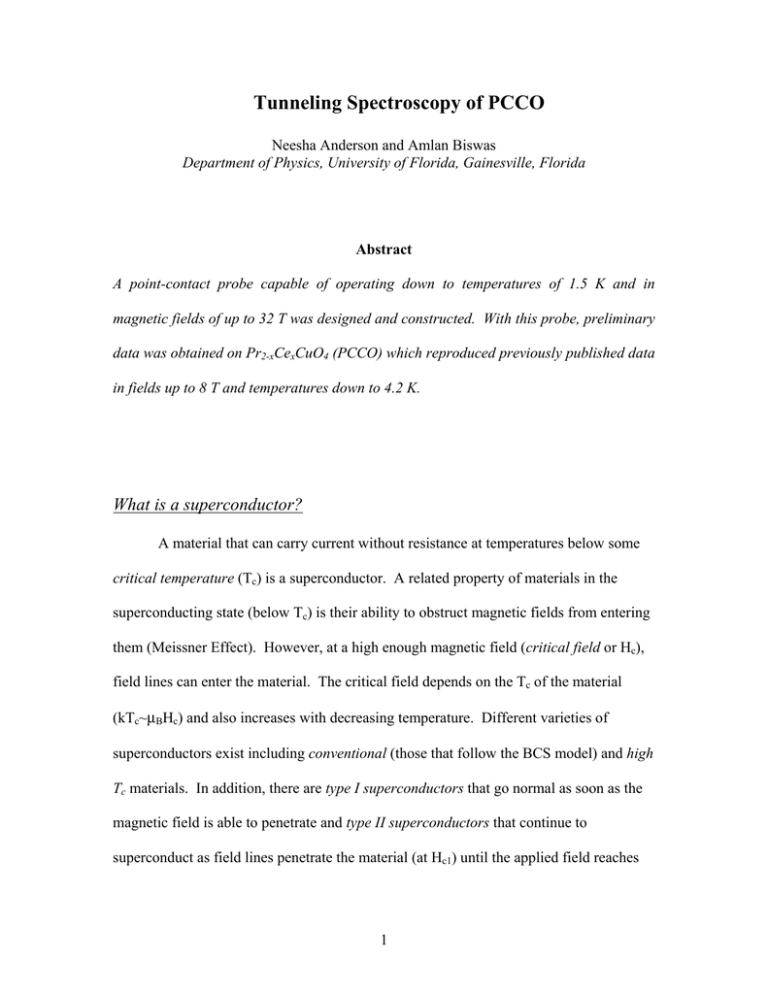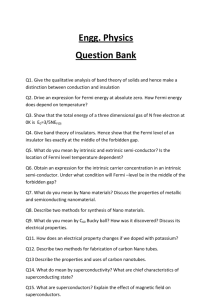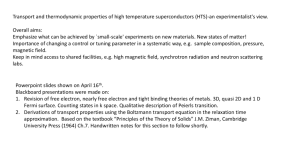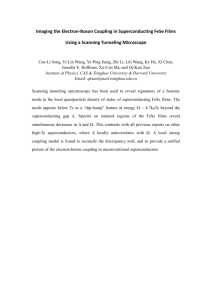Tunneling Spectroscopy of PCCO
advertisement

Tunneling Spectroscopy of PCCO Neesha Anderson and Amlan Biswas Department of Physics, University of Florida, Gainesville, Florida Abstract A point-contact probe capable of operating down to temperatures of 1.5 K and in magnetic fields of up to 32 T was designed and constructed. With this probe, preliminary data was obtained on Pr2-xCexCuO4 (PCCO) which reproduced previously published data in fields up to 8 T and temperatures down to 4.2 K. What is a superconductor? A material that can carry current without resistance at temperatures below some critical temperature (Tc) is a superconductor. A related property of materials in the superconducting state (below Tc) is their ability to obstruct magnetic fields from entering them (Meissner Effect). However, at a high enough magnetic field (critical field or Hc), field lines can enter the material. The critical field depends on the Tc of the material (kTc~µBHc) and also increases with decreasing temperature. Different varieties of superconductors exist including conventional (those that follow the BCS model) and high Tc materials. In addition, there are type I superconductors that go normal as soon as the magnetic field is able to penetrate and type II superconductors that continue to superconduct as field lines penetrate the material (at Hc1) until the applied field reaches 1 some critical level (Hc2). All high Tc materials and some conventional materials are type II. What is going on inside a material when it superconducts? Theories including the BCS model and the Ginzburg-Landau model can explain most of the observed phenomena of the conventional superconductors. However, the high Tc superconductors are different from conventional materials and current theories to explain their behavior (including modified BCS models) are still incomplete. The information experimental groups like ours gather leads to a more complete picture of how these high Tc materials behave, which, in turn, leads to more complete and consistent theories. When a material undergoes a gas to liquid transition, we describe it as a condensation in real space. Analogously, the transition to the superconducting state is a condensation within the material. However, this condensation occurs in momentum space. It is quantum mechanically forbidden for fermions (which include electrons) to occupy the same quantum state. However, in a superconductor, the electrons condense in pairs (known as Cooper pairs) and the pairs are bosons. (Fermions have half-integer spins and bosons have integral spins). The Fermi surface Fermions are described by Fermi-Dirac statistics. At absolute zero, all energy states from the ground state up to the Fermi energy are occupied and all states above the Fermi energy are empty. When a material goes superconducting, electrons with energies in an energy range ±∆ about the Fermi energy condense to the Fermi energy. When this condensation happens, a superconducting energy gap 2∆ is formed. We can depict the 2 momentum of an electron as a vector emanating from the origin of momentum space. The tips of all the maximum electron momentum vectors form a surface, known as the Fermi surface. When electron pairs condense to the Fermi energy, a gap forms in the Fermi surface (a gap in energy is a gap in momentum since E=½mv2=p2/2m where p is the momentum of the particle). In conventional superconductors, all electrons within energy ±∆ of the Fermi energy condense, regardless of the direction of their momentum vectors. This forms an s-wave symmetric gap in the Fermi surface. The BTK model is a theory that explains the tunneling spectroscopy of s-wave symmetric superconductors. A modified version of this model aids physicists in determining the symmetry of high Tc materials. In the cuprates we study, the symmetry of the gap is of current interest and debate (in our case the superconductivity takes place in plane, so the Fermi surface gap is two-dimensional.) Andreev reflection and the zero bias conductance peak Early research suggested that the high Tc superconductors have a d-wave symmetric gap (see Fig. 1) [1,2]. However, the absence of a zero bias conductance peak (ZBCP) in the tunneling spectra of some overdoped materials is one piece of evidence for s-wave symmetry. FIGURE 1. The d-wave gap symmetry. Researchers have suggested a d to s-wave transition across the doping spectrum [3]. Effects like the ZBCP appear at low bias 3 voltage when electrons with energy in the gap region attempt to tunnel from the metal to the superconductor. In order to tunnel through, a new electron and a hole are created, the new electron pairing with the first (recall that electrons exist only in pairs in the gap region.) This process is called Andreev reflection. Investigating high Tc superconductors Understanding the process of high temperature (high Tc) superconductivity interests researchers at a purely intellectual level and also for the great potential in application. Although current application of superconductors is limited due to the low temperatures necessary, superconductors are already being used as filters in cellular phone base stations [4]. The holy grail of superconductivity research is a material that can superconduct at room temperature. The most obvious application for superconductors is resistance free power transmission. We get clues as to how high Tc materials superconduct by studying their properties under environments such as applied magnetic fields and varying temperatures. Additionally, we look at different forms of the material (thin films, bulk crystals, various ratios of ions or doping levels). Also, the properties of these materials in the normal state are anomalous and give insight into the mechanism of superconductivity. Specifically, the mechanism that causes the Cooper pairs to form depends on the electronic properties of the normal state. The most widely studied group of high Tc materials are the cuprates- known for their layered structure and, more specifically, a copper oxygen plane where the superconductivity takes place. In our lab we study the cuprate Pr2-xCexCuO4 (PCCO) at 4 doping levels of x=0.13 (underdoped), x=0.15 (optimally doped), and x=0.17 (overdoped) (see Fig. 2). PCCO is an electron doped (or n-doped) material, meaning the transport properties are governed by electrons. Other materials, in which the transport properties are governed by “holes” or electron absences, are known as hole-doped (or p-doped.) The magnetic field necessary to drive PCCO to the normal state is of the order of 10 Tesla but varies with temperature and doping level [5]. Phase Diagrams and the Pseudogap A phase diagram shows the physical FIGURE 2. The structure of PCCO. states of two types of cuprate materials as a function of doping level and temperature (see Fig.3). The phase diagram for the holedoped (or p-doped) variety of cuprates is much more complete. The electron-doped materials, like the PCCO that we study, need a more complete phase diagram. Currently, many condensed matter physicists are trying to better understand the pseudogap region of the phase diagram for both kinds of dopings. The pseudogap is a normal state gap seen in the tunneling spectra of cuprates at low temperatures. In conventional superconductors, this gap is not seen because the pairing of electrons and momentum condensation, (final step for superconductivity), occur at the same temperature. It is believed that in cuprates, first the pairing occurs, followed by the momentum condensation. Thus, even before the material 5 superconducts, a gap appears (however no coherence peaks are seen). As Fig. 3 shows, for a particular doping range, the pairing may occur although the material never superconducts. Also note that for certain dopings, the cuprates become an antiferromagnetic insulator instead of a superconductor at some critical temperature. (In an antiferromagnetic material, neighboring electrons have spins aligned antiparallel to each other.) The antiferromagnetic nature of cuprates can reveal more about the mechanism behind cuprate superconductivity. For example, it has been suggested that quantum fluctuations in an antiferromagnetic material could destroy the long-range antiferromagnetic order resulting in pairs of electrons locked in an antiparallel configuration [6]. FIGURE 3. Phase diagrams for electron doped (left) and hole doped (right) cuprates Tunneling and point contact spectroscopy of superconductors Our research investigates how the current (I) changes across a normal metal to cuprate junction as we vary the strength of a barrier between the two materials and as we vary the voltage (V) across the junction. More precisely, we measure dI/dV (known as the differential conductance.) At high barrier strength (high Z), the current across the 6 junction is primarily due to quantum tunneling. (At a barrier, the wave function of a particle can extend to the other side of the barrier. This means a probability that the particle will appear at the other side or tunnel, although classically this is impossible.) The tunneling spectra (dI/dV vs. V at high barrier) are important because they provide information on the density of states of a given material (the density of states is proportional to the differential conductance.) As a result, we can measure the superconducting gap from the tunneling spectrum of a superconductor. In addition, a ZBCP which is sometimes observed in the tunneling spectrum is evidence of a d-wave symmetric gap. Electronics and software has been designed to measure tunneling spectra including programs to measure dI/dV as a function of V and resistance as a function of temperature. Also, we have created a setup which includes a lock-in amplifier to allow us to measure dI/dV directly rather than measuring I vs. V and then taking numerical derivatives. Measuring dI/dV directly is advantageous because the numerical derivatives involve estimates which introduce noise in the graphs. We use a function generator to create the voltage across the junction and sweep the voltage from a negative voltage to a positive one. We add a much smaller sinusoidally alternating voltage to this bias voltage. The current through the junction is then given by, I(Vo + ∆Vsin(wt)) = I(Vo) + (dI/dV)∆Vsin(wt) +… 7 FIGURE 4. Our method of point contact. In the final design (fig. ) the screw was parallel to the phosphor bronze plate. where Vo is the potential due to the DC and ∆Vsin(wt) is due to the AC. The lock-in amplifier is able to read the amplitude of the small alternating current and, in this way, we can directly read dI/dV. We made junctions of Platinum-Rhodium (Pt-Rh) wire and PCCO thin films and used a cantilever to make contact between the two, with the wire attached to the top part of the cantilever and the PCCO attached to the bottom (see Fig.4). PCCO thin film is made by depositing ions onto a substrate that matches the lattice structure of the PCCO film itself (enabling the PCCO lattice to form on top.) A barrier was created by allowing the PCCO film to oxidize in air for a few minutes. Then by pressing a screw onto the cantilever, the Pt-Rh wire was pressed against the oxide layer. This setup differs in two main ways from standard point contact spectroscopy: (1) instead of the tip of a FIGURE 5. The worm gear is accessible from outside the dewar. wire touching the PCCO, we are making contact with the long side of the wire, and (2) because we are using a delicate mechanism, we go from barriers sufficient for tunneling to point contact barriers FIGURE 6. The screw and cantilever. with standard current transmission. The cantilever was seated at the bottom of a probe 6 ft. in length, and the probe was inserted into a dewar. (A dewar is a sealed, insulated container designed to reach low temperatures by holding liquid nitrogen or liquid helium. The dewars we use are equipped with superconducting or resistive magnets capable of generating high magnetic fields within the dewar.) A worm gear at the top of the probe allows us to press the cantilever (and thus vary the barrier strength) from outside the dewar while the sample remained at low 8 temperature (down to 1.2 K) (see Fig. 5). The worm must be rotated 48 times for the gear to complete one revolution. As the gear revolves, a screw presses harder (or softer, depending on the direction of rotation) on the cantilever. By using the worm gear and a cantilever, as opposed to a simpler configuration to make a junction, we have precise control and achieve low barrier strengths. Since the probe will be used to take data at the high magnetic field lab in Tallahassee, it had to be made ½ inch in diameter to fit the parameters of the magnet we will use there and some parts of the probe had to be made with a Macor® ceramic that would not contract at low temperatures. Also, we had to consider the orientation of the magnetic field in the dewar. Only magnetic fields perpendicular to the a-b plane in the cuprate structure will drive the cuprates normal. The magnetic field of the magnet we are using in Tallahassee is along the axis of our probe. We needed to orient the cantilever so that the PCCO film would have its a-b plane perpendicular to the magnetic field, although in this configuration the screw brushes the cantilever plate along the free end of cantilever rather than presses at a 90 degree angle to the cantilever plate (see Fig. 6). FIGURE 7. Design of the probe. The screw which presses the cantilever is in blue. The cantilever is not pictured. Our results: testing the point contact probe 9 We tested the probe using the dewar in our lab. The lab dewar is equipped with a superconducting magnet that reaches fields of 9 Tesla (T). A thin film of Pr2-xCexCuO4 with x=0.15 (optimal doping) was used for these test runs. The first two runs (no magnetic field) show well defined coherence peaks (thus a well defined energy gap) (see Fig. 8). Coherence peaks are the two local maxima seen on either side of the zero bias voltage (Fig. 8). These peaks occur because the density of states is very large near the gap boundary in superconductors. In agreement with previous results [5], we see no ZBCP in the optimally doped PCCO. This could be evidence for an s-wave symmetric gap in optimally doped PCCO. However, the width of the ZBCP in PCCO is predicted to be very narrow and in experiments the ZBCP could be easily suppressed by thermal effects and disorder. The asymmetries in the graphs appear most likely because each of the two materials has a different work function and possibly because of the different shapes of the materials. The Z value (barrier strength) can be estimated from the ratio between the dI/dV at zero bias and the dI/dV well outside the gap region. Note that these initial runs measured I vs. V data and the dI/dV graphs were attained by numerical differentiation. 2∆ 0.020 dI/dV (S) dI/dV (S) 0.020 0.018 0.018 0.016 0.016 -15.0 -10.0 -5.0 0.0 5.0 10.0 -20.0 15.0 -15.0 -10.0 -5.0 0.0 5.0 bias voltage (mV) bias voltage (mV) FIGURE 8. First point contact data (at 0 Tesla) 10 10.0 15.0 20.0 After increasing the resistance of the junction, we ran 0.00074 another voltage sweep (from 25mV 0.00072 0.00070 to -25mV) across the junction in the field (see Fig. 9). In these runs, the coherence peaks are not well defined. dI/dV (S) presence of a 0 T field and an 8 T 0.00068 0.00066 0.00064 0.00062 0 tesla 8 tesla 0.00060 0.00058 0.00056 -20.0 -15.0 -10.0 We believe this is due to a high resistance junction. (The PCCO that we used was a relatively thin (~700 -5.0 0.0 5.0 10.0 15.0 20.0 bias voltage (mV) FIGURE 9. Comparison of point contact data (dI/dV) at 0 T (superconducting PCCO) and 8 T (normal PCCO). Å) film with a thin contact area. This could be the reason for such high resistance junctions regardless of the strength of the wire-PCCO contact. In trying to attain lower resistance junctions, it seemed that we pressed the materials close enough to destroy the tunneling barrier. Therefore, after the runs depicted in Fig.8, additional runs were made with high resistance junctions.) Notice that even when the PCCO is normal at 8 T, we see a gap region. This is evidence for a pseudogap. Data acquired at higher fields (in Tallahassee) will help support or undermine current ideas about the pseudogap. Data were taken using the lock-in amplifier setup to take dI/dV directly (see Fig. 10). Taking direct dI/dV measurements resulted is smoother graphs. Once again, the junction resistance is high and we do not see coherence peaks. 11 8.4 6.3 8.2 6.2 dI/dV (arb. units) dI/dV (arb. units) 8.0 6.1 6.0 7.8 7.6 7.4 0 tesla 8 tesla 7.2 5.9 -20.0 -15.0 -10.0 -5.0 0.0 5.0 10.0 15.0 20.0 -20.0 -15.0 -10.0 -5.0 0.0 5.0 10.0 15.0 20.0 bias voltage (mV) bias voltage (mV) FIGURE 10. dI/dV measured directly at 8 T (left) and 0 T (right). Summary We designed and constructed a point-contact probe for experiments in the high magnetic field lab in Tallahassee. With this probe, we obtained preliminary data on Pr2-xCexCuO4 (PCCO) which reproduced previously published data [5] in fields up to 8 T and temperatures down to 4.2 K. Future experiments in Tallahassee will take tunneling data in temperatures down to 1.5 K and in fields of up to 32 T. Acknowledgments I thank the National Science Foundation and the University of Florida for funding my research this summer. Thanks to Dr. Kevin Ingersent, Dr. Alan Dorsey, and Wayne Bomstad for overseeing UF’s REU program. I thank my lab mates Sung-Hee Yun and Tara Dhakal for all their help. Thanks to the machine shop guys for their excellent work. 12 Finally, I thank my advisor, Dr. Amlan Biswas, for his continuous guidance throughout this project. References [1] Covington et al., Phys. Rev. Lett. 79, 277–280 (1997). [2] Dagan et al., Phys. Rev. B 64, 092509 (2001). [3] Amlan Biswas et al., Phys. Rev. Lett. 88, 207004 (2002). [4] Hank Hogan, Ind. Phys., 3, 7 (1997). [5] M. M. QazilbashT et al., Phys. Rev. B 68, 024502 (2003). [6] J. Orenstein and A.J. Millis, Science 288, 468 (2000). 13





